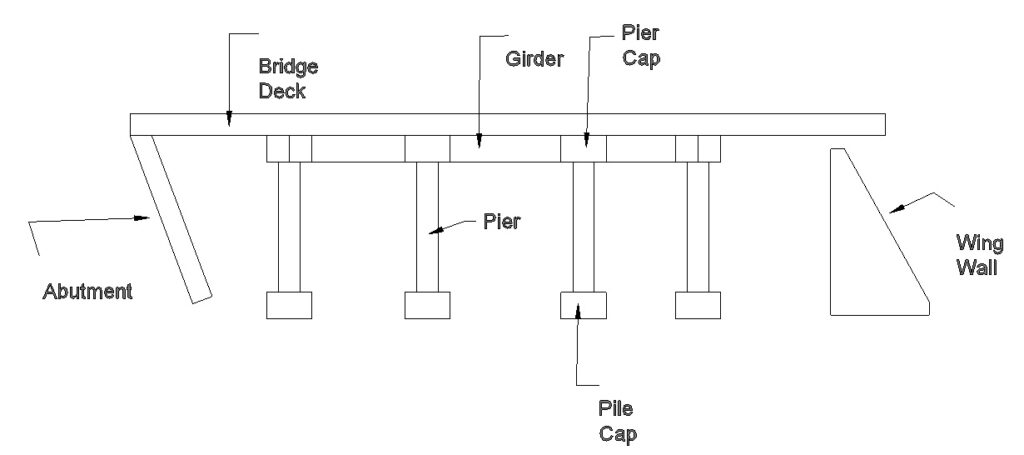This article explains difference between pier and abutment.
Before knowing difference between pier and abutment, we will get brief idea of pier and abutment.
Table of Contents
What Is Pier?
The intermediate supports for the superstructure of a multi-span bridge are called piers.
A pier basically comprises two parts i.e a column shaft and the foundation. It is sometimes provided with projections, called cut water, and easy passage of water.
Function Of Pier:
The purpose of a pier is to transmit the load from the bridge to the underneath sub-soil.
Types Of Piers:
Based on the type of superstructure, sub-soil conditions, and the construction procedure of the bridge, the pier can be classified into the following two types:
1. Solid piers
2. Open piers.

What Is Abutments?
The end supports of a bridge superstructure are called abutments.
Abutments are constructed either with brick masonry, stone masonry, mass concrete, precast concrete blocks, or RCC. The top surface of the abutment is made flat for girder bridges or semi-circular arch bridges but stipulates with skewbacks if the bridge arches are segmental or elliptical.
Function Of Abutments:
- To transfer the load from the bridge superstructure to the underlying sub-soil.
- To cater the final formation level to the bridge superstructure.
- To carry the earth pressure of embankment of the approaches.
Types Of abutments:
Based on the layout plan abutments are classified into the following types:
1. Abutments with wing walls.
2. Abutments without wing walls.
Pier Vs Abutment: Differences
I also listed the key differences between Pier and Abutment in tabular form.
| Pier | Abutment |
|---|---|
| Typically located in the middle of a bridge | Located at the ends of a bridge |
| Pier is intermediate support for the superstructure of a multi-span bridge. | Abutments are the end supports of a bridge superstructure. |
| It should consist of two parts i.e. a column shaft and the foundation. | It is built either with brick masonry, stone masonry, mass concrete, precast concrete blocks, or RCC. |
| The primary purpose of a pier is to transfer the load from the bridge to the underneath sub-soil. | The primary purpose of Abutments is to support the ends of the bridge and transfer the loads from the superstructure into the ground. |
| Supports the weight of the bridge | Transfers the weight of the bridge to the ground |
| Typically vertical or slightly sloping | Typically horizontal or sloping |
| Taller than abutments | Shorter than piers |
| Larger than abutments | Smaller than piers |
| Multiple piers may be used to support a long bridge | Typically, only two abutments are used for a bridge |
| Made of concrete, steel, or other strong materials | Made of similar materials as the bridge |
| Designed to support heavy loads | Designed to withstand the weight of the bridge |
| May obstruct water flow | May allow water flow to pass through |
| May not be accessible to vehicles or pedestrians | May be accessible to vehicles or pedestrians |
| Typically more expensive than abutments | Typically less expensive than piers |
| Can be longer or shorter than abutments depending on the span of the bridge | Generally shorter in length than piers |
| Generally narrower than abutments | Generally wider than piers |
| Provides vertical support to the bridge deck | Provides lateral support to the bridge deck |
| May have multiple levels or decks | Typically only one level |
| Can be cylindrical, rectangular, or other shapes | Typically rectangular in shape |
| May require deep foundations | Foundations may not need to be as deep |
| Can be used in suspension bridges | Not used in suspension bridges |
| Can be used in cable-stayed bridges | Not used in cable-stayed bridges |
| May require regular maintenance | May require less maintenance |
| Typically spaced at regular intervals along the bridge | Only located at the ends of the bridge |
| Can be used in arch bridges | Not used in arch bridges |
| May be used as aesthetic elements in bridge design | Typically not used as aesthetic elements |
| Can be used to protect the bridge from debris | Typically not used to protect the bridge |
| May be subject to vibration and oscillation | Typically less subject to vibration and oscillation |
| Can be used as navigation aids for ships | Typically not used as navigation aids |
| Can be used as foundations for other structures, such as buildings or piers | Typically not used as foundations for other structures |
